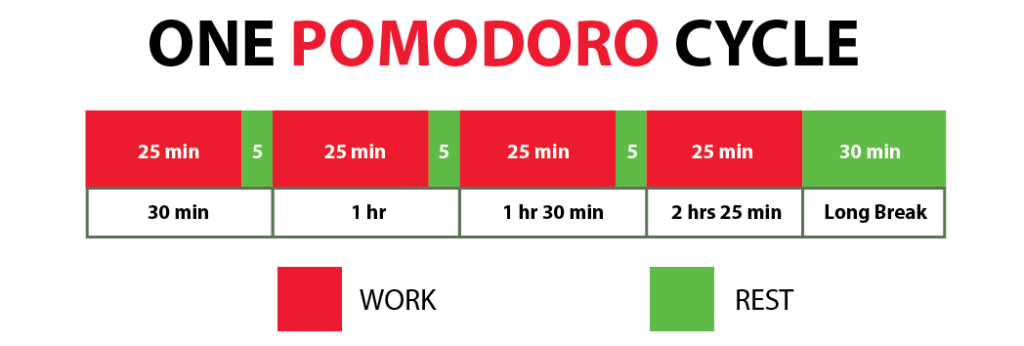Working a sedentary job all day comes with its challenges.
Staying focused can be a chore if you are easily distracted by constant emails, text messages, meetings, or any other notifications.
It’s also a struggle to remember to get in movement throughout the day because you have so much to do before the clock hits 5PM.
Having a plan of attack for being productive while allowing yourself time to move around during working hours is imperative to any desk jockeys’ health.
This is where the Pomodoro Technique comes in.
What Is The Pomodoro Technique?
The Pomodoro Technique is primarily a time management tool that is meant to turn your work time into chunks with little breaks in between.
What this technique also does, inadvertently, is remind you to get up and move around.
The way the Pomodoro Technique works is that you set a timer for 25-30 minutes and focus solely on your work (no checking email, text messages, etc.) during this time.
Once your 25-30 minutes is over, you’ll take a short 5 minute break to do whatever you want.
These short breaks are where you’ll be able to burn some extra calories.
This process will repeat for 4 cycles. After 4 working cycles, your 4th break will be much longer (roughly 15-30 minutes).
This 15-30 minute break gives you ample time to take a walk around the office or incorporate movement breaks and stretches to help undo the damage from sitting.
Once you’ve finished your long break you’ll start the cycle all over again.

Source: Roamingincome.com
This structured work routine helps to keep you laser focused on the task at hand whether it’s coding, designing, reconciling, or clearing out your 104 unread emails.
The beauty of the Pomodoro Technique is that it forces you to dedicate a bunch of small and large breaks throughout the work day which are prime time for movement (aka calorie burning).
What To Do During Movement Breaks
There is no correct way to spend your short or long breaks with the exception of 1 rule:
You Must Stand Up!
The whole idea of taking these breaks is to get your body moving and your mind refreshed for the next working cycle.
Movement can be anything you want such as standing, stretching, squatting, walking to the bathroom, picking your nose, you get the idea.
Just listen to your body and understand what your goals are.
If you’re wanting to lose weight and you are having neck pain then maybe spend your short breaks doing (standing!) neck stretches and your long breaks taking a walk.
If you want to improve your hip mobility and do some strength training you can do squats or wall sits on your short breaks and hip stretches during your long breaks.
Or just walk around on each break if that’s what you enjoy. Like I said, there is no correct way to do a movement break.
It’s simply a matter of what you’re trying to improve or correct.
How Many Extra Burned Calories Are We Talking?
Excellent questions I’m glad you asked.
Let me give you a scenario using myself as the guinea pig.
I am a 30 year old, 5’ 8”, 160 pound accountant working for a Fortune 500 company.
It’s the company’s fiscal year end which means I won’t be getting up from my computer much as I have a lot of reconciliations and journal entries that need to be processed before the end of the week or my ass is grass.
Assuming I work from 8am to 5pm and get 1 hour for a lunch break (which I go out and get so I can walk) I am roughly sitting at my desk for 8 hours and moving for 1 hour.
That means I would burn roughly 746 calories per day while at work.

Source: Startstanding.org
Now, let’s change the parameters a bit.
What if I worked the same amount of hours but this time implemented the Pomodoro Technique and sat for 6 hours and stood for 3 hours (let’s assume your movement breaks were you standing up and nothing else).
This would come out to roughly 947 calories burned each day at work.

Source: Startstanding.org
That’s an extra 201 calories burned per day or 1,005 calories per week!
And remember, that’s just assuming I only stood during your breaks. If I stretched or went for walks then the number of calories burned would only increase.
These calories add up throughout the weeks and months and can make losing weight a little easier just by implementing scheduled breaks using the Pomodoro Technique.
If you’d like to calculate your own sit/stand scenario go to www.startstanding.org
The Pomodoro Technique is a very useful tool for burning more calories at work and improving your productivity overall.
I recommend giving the Pomodoro Technique a try for 1 full work week and compare it to the week prior.
Hopefully you’ll notice an improvement in your productivity and in the way your body looks and feels (assuming you’re still eating a well balanced diet and exercising, of course.)



Leave A Comment